Sauerkraut is nothing more than white cabbage preserved by fermentation, or lactic acid fermentation, and is probably one of the best-known German dishes. Kraut has also been adopted as a stereotyping term for Germans worldwide.
I am a real Kraut Rocker.
Jump to recipeSince cabbage is such a good staple food, you can make sauerkraut almost all year round. Still, I prefer to make our sauerkraut in the fall because I love the regional fresh Ackerpille from Westhof in the Dithmarscher Marsch, behind the dike on the North Sea. Ackerpille is a type of primal white cabbage, flatter, looser and less bloating than regular cabbages. It's easy to knead brine from Ackerpille, so it's good for beginners. If you have the chance, definitely try them! You can also use pointy cabbage, which will result in a softer sauerkraut.
Traditionally, wooden barrels and earthenware fermentation crocks were used to make sauerkraut. To allow air sealing and simultaneous escape of gases, many ceramic fermentation pots have a circumferential water channel in which the lid sits and prevents oxygen from entering. Just as well and suitable for fermenting in small quantities at home work jars with rubber seals, swing-top jars or weck brand canning jars.
Sauerkraut variations
The great thing is that you can enjoy sauerkraut in an infinite number of flavors by adding different herbs, spices or spice blends. Taste your way through the flavors and ferment many small test jars until you have found your personal favorites.
Basic ingredients for a 1-liter jar
- 700 - 800 gr. white cabbage
- 16 gr. rock salt (2%)
Dill Kraut
- 1 bunch of fresh dill
- 1 medium sized white onion
Finely slice the onion and incorporate while kneading. The dill is left whole and placed in layers between the kneaded cabbage when filling the jar.
Donnerkraut
- 1-2 tsp tandoori masala
- 2 garlic cloves
- 1 medium sized red onion
Finely slice the onion, chop the garlic. Sprinkle with the seasoning and knead. Why is this kraut called Donnerkraut (thunder kraut in English), you want to know? Because a Mr. Donner inspired me to this combination, I answer you.
Za'atar Kraut
Za'atarkraut, that is sauerkraut with my homemade Za'atar spice mixture, is the declared favorite ferment of my youngest son. And for good reason. Sumac, oregano and sesame bring wonderful tart, fresh and aromatic nutty flavors to the otherwise simple sauerkraut.
For my Za'atar blend I mix oregano, sumac, roasted white sesame and salt. The amounts in this order, oregano > sumac > sesame > salt. Of course you can also buy the seasoning at the store, then you might find some other ingredients in it. In the Arabic region, for example, Syrian hyssop is used instead of oregano.
- 1 large white or red onion (about 150 gr.)
- 1 garlic clove
- 4 heaped tsp Za'atar spice
Chucrut Mexicano
- 3 green jalapeños
- ¼ red bell bell pepper
- 1 garlic clove
- 1 medium sized white onion
- smoked salt
Finely slice the onion and jalapeños, chop the garlic. Cut the red bell pepper into small pieces. Replace half of the salt with the smoked salt. Knead everything together - use gloves!
Not so common recipes
Georgian Kraut
Ukrainian Pelustka
Curtido Salvadoreño
Ferment your own wine sauerkraut
Dishes with sauerkraut
The best probiotic and positive effect on health has the kraut, of course, raw and unheated. I love to snack on a small bowl of sauerkraut in the evening. It also tastes fabulous as an ingredient in a nice salad or as a cold side dish with smoked tofu or fish.
A delicious cooked dish is sauerkraut goulash, with lots of braised onions, clarified butter and bell peppers.
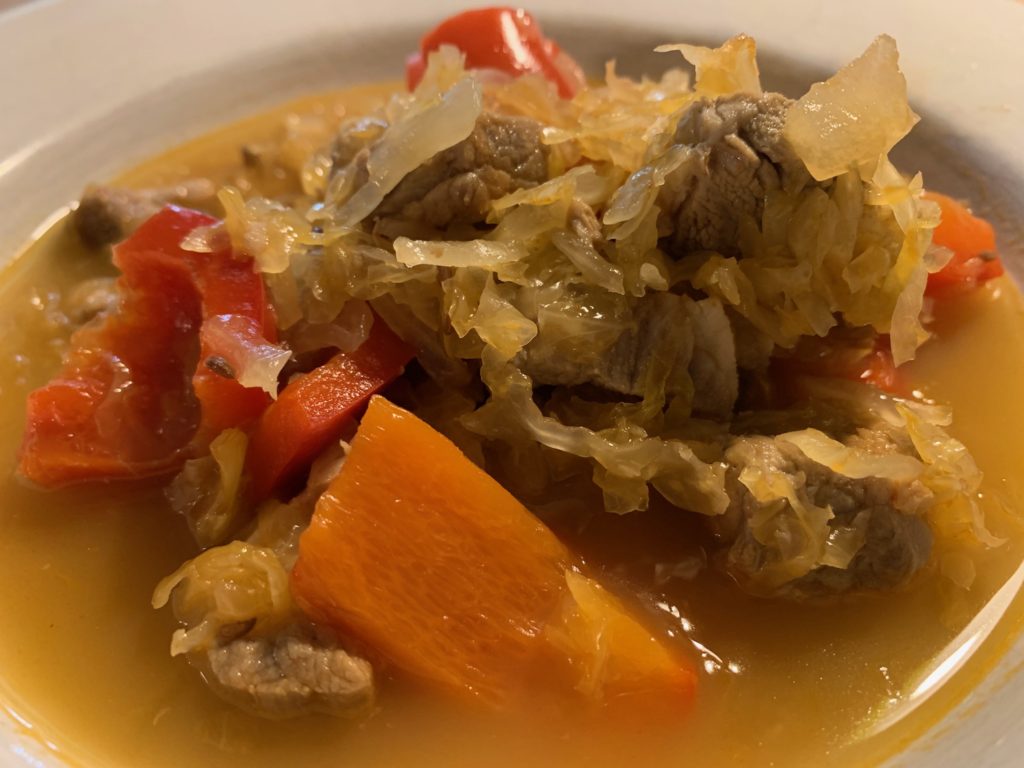
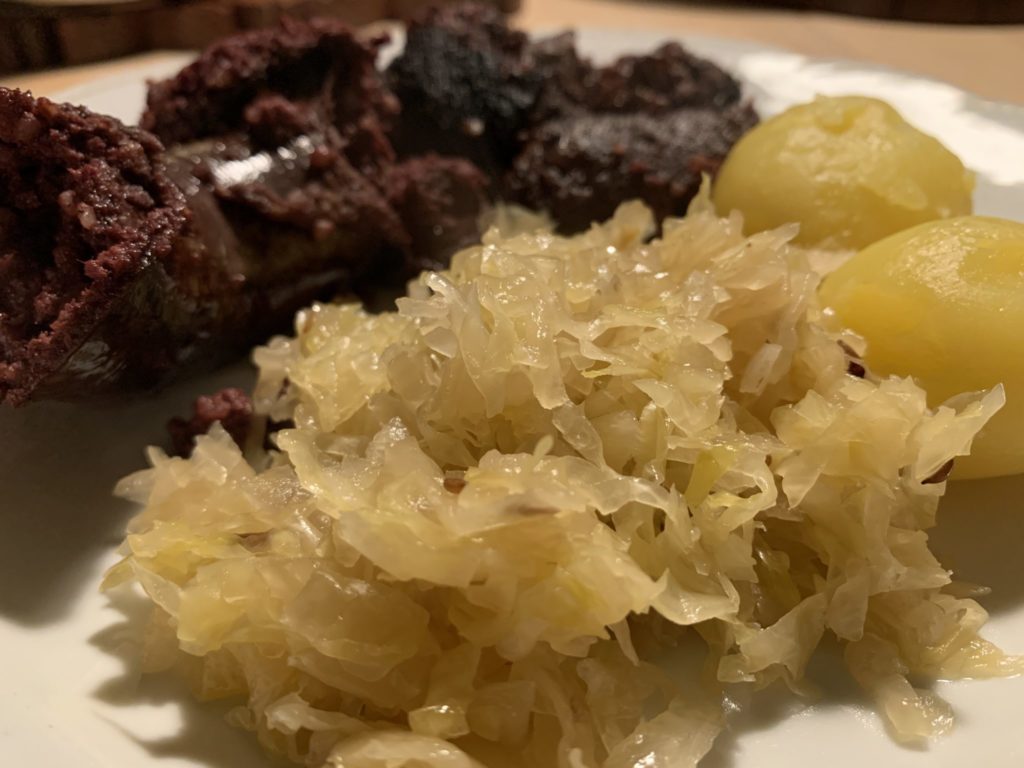
However, my favorite way to eat sauerkraut is with boiled potatoes, my mom and two kinds of black pudding. With and without raisins. The pudding, not the cabbage or the mother, of course.
When heating up sauerkraut, you lose the pure probiotic effect. But that doesn't matter, because it tastes so good and still has enough healthy ingredients.
And if you juice your raw sauerkraut, you get homemade sauerkraut juice. Sauerkraut juice contains a lot of vitamin C, lactic acid and live lactic acid bacteria and has a digestive stimulating effect on most people.

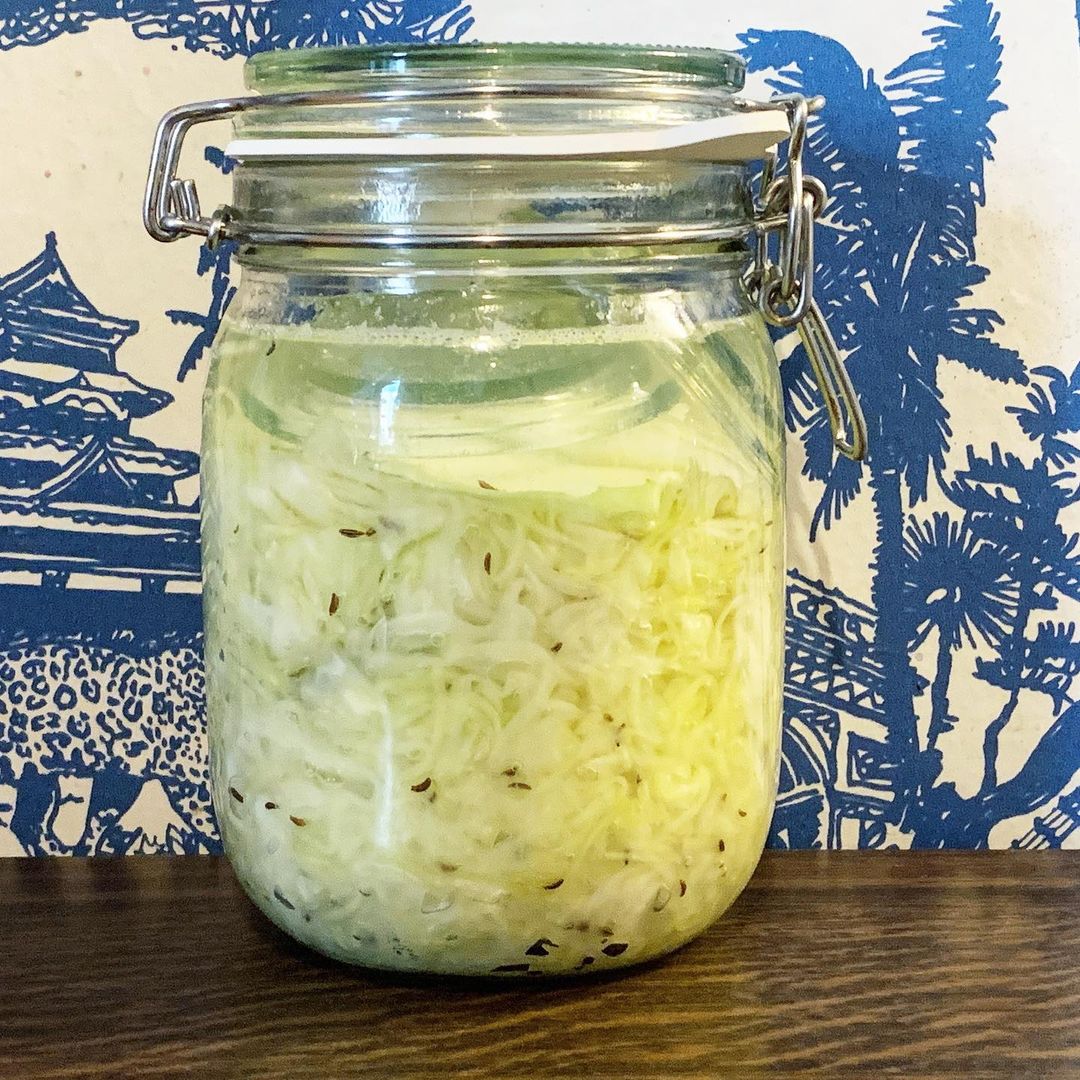
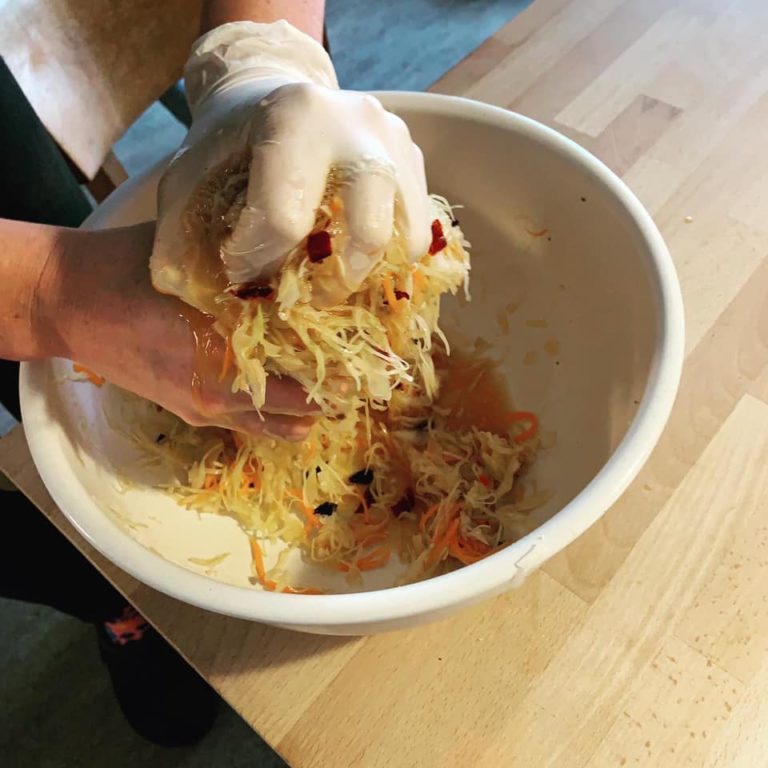
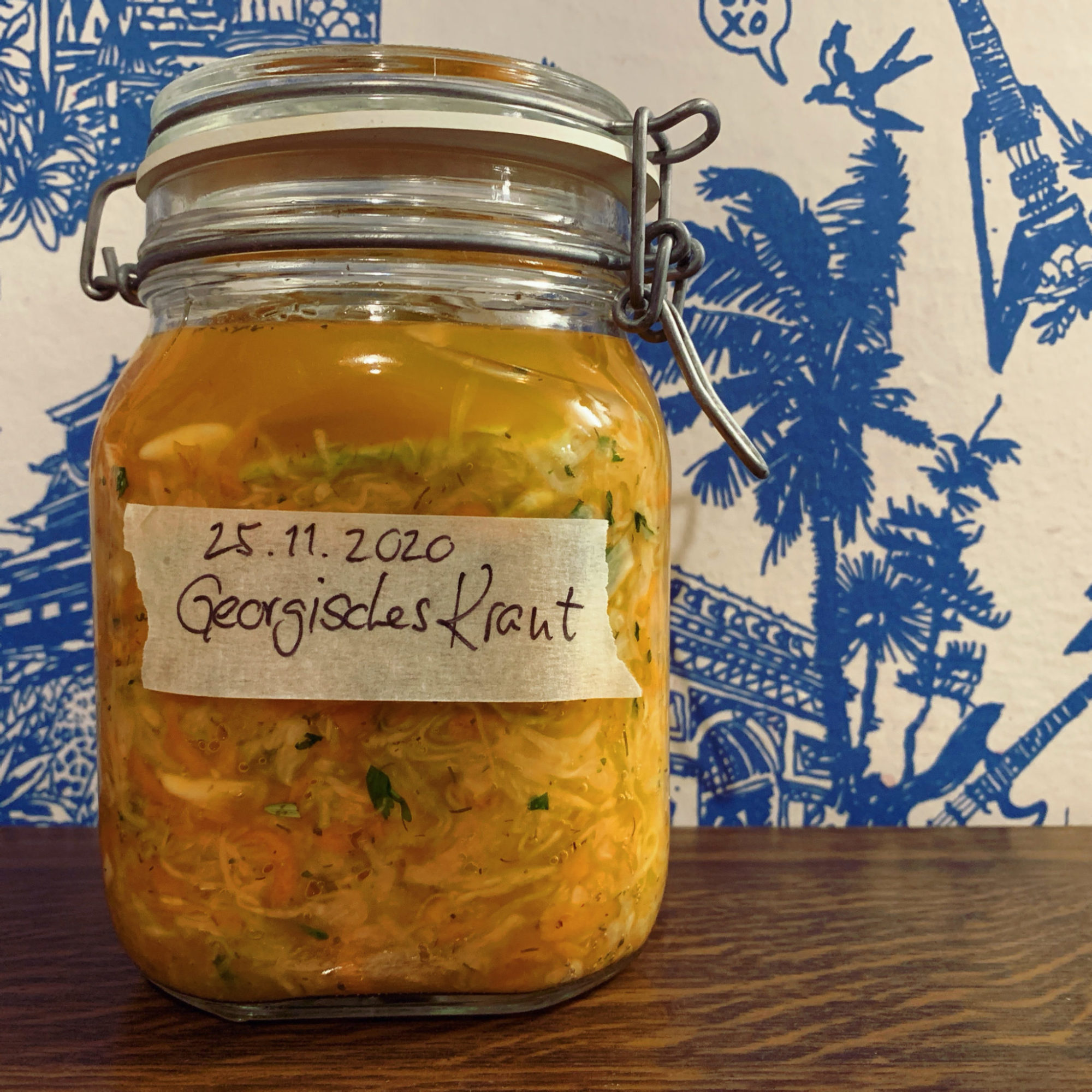


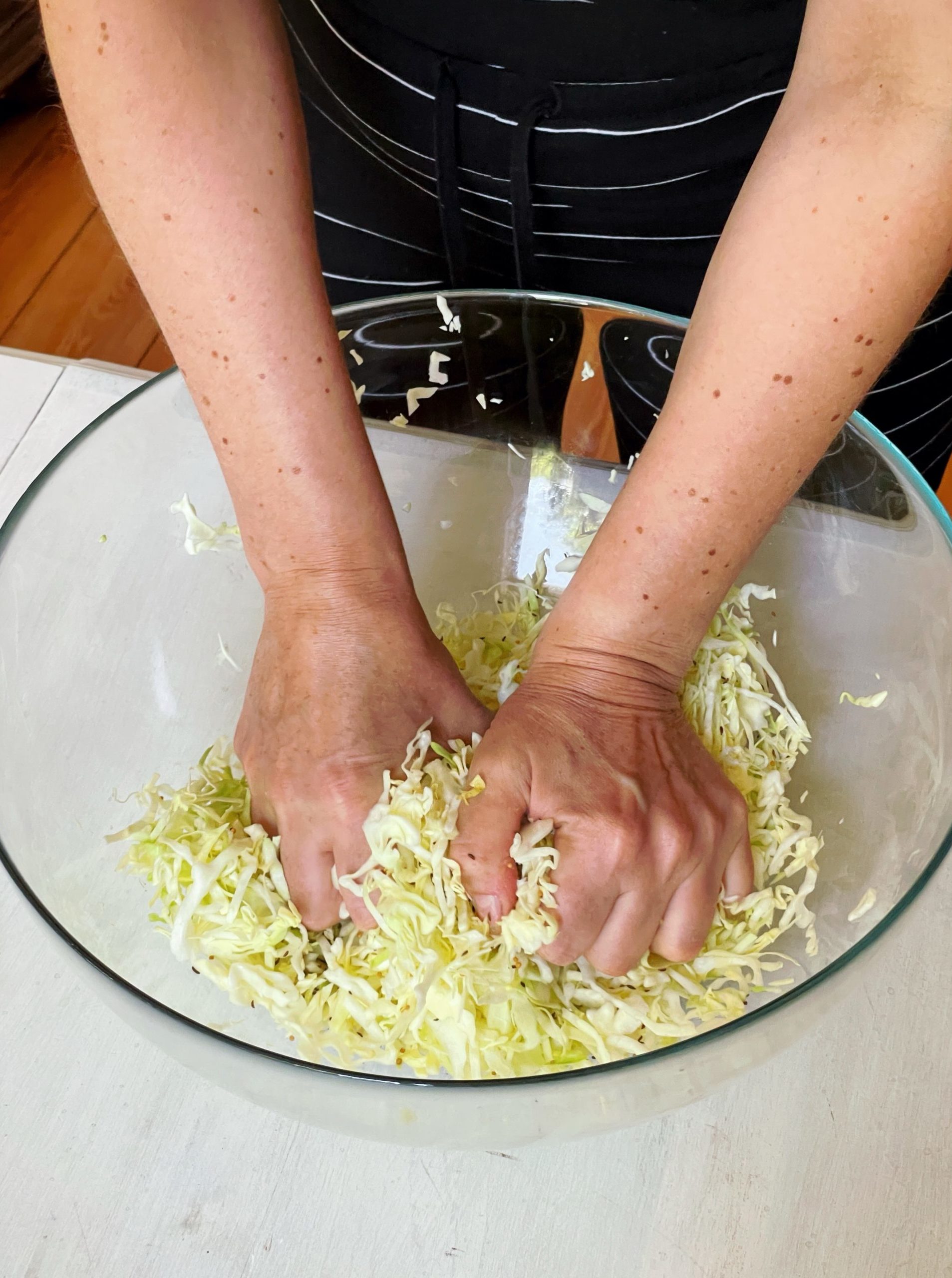
liebe Katsu,
bei Zeitnot oder wenn es keinen Grund gibt, sich “abzureagieren” 😉 😉 , kann man einfach die Osmose für sich arbeiten lassen:
das Gehobelte mit dem Salz vermischen, mindestens 30 Min. ruhen lassen während man die nächste Portion in ein weiteres Gefäß hobelt, (oder einfach nichts tun…) und schon hat das Kraut ordentlich Lake… (ich war mal zu müde und ließ das Ganze einfach abgedeckt über Nacht “arbeiten”… kein Problem…)
Das Donnerkraut werde ich auch mal testen… DANKE für die Idee
Liebe Susanne,
das stimmt und ist wirklich praktisch! Darum steht es oben auch gleich im nächsten Satz, nachdem ich verrate, dass ich mein Kraut als Boxsack missbrauche 😉
Bei Kimchi benutzt man ja auch genau diese Technik.
Das Donnerkraut schmeckt wirklich fantastisch, viel Spass beim Nachbauen und guten Appetit 😋
Liebe Grüße,
Katsu
Hast du auch ein Rezept mit Rotkohl und Apfel? Wie sind da die Mengenangabe zwischen Apfel und Kohl? 🙂 liebe Grüße Silvi
Liebe Silvi,
nein, Rotkohl mit Apfel gibt es bei mir gekocht. In fermentiert schmeckt mir die Kombi nicht. Wenn Du es versuchen möchtest, nimm nicht zu viel Apfel – der Zucker wird zu Säure und Alkohol, und der Geschmack wird schnell dominant.
Gutes Gelingen!
Katsu
Hallo Katsu,
ich bin mit dem Rezept “Knoblauch in Honig fermentiert” gestartet. Hier steht dabei, dass man das Glas am Anfang täglich öffnen sollte. Nun stellt sich mir die Frage, ob das bei den anderen Rezepten genau so ist?
Gerne möchte ich das Sauerkraut und Kimchi ausprobieren, ohne Gefahr zu laufen, dass die Bügelgläser das nicht mitmachen 😀
Vielen Dank schonmal für deine Antwort.
Moin Falk,
nein, bitte nicht. Ich habe es bei dem Rezept Garlic fermented in honey dazu geschrieben, weil es in dem Fall ausnahmsweise nötig ist. Ansonsten ist es wirklich genau andersrum, die Gläser sollen geschlossen bleiben. Und das können sie auch ohne Probleme, weil Bügelgläser dafür gemacht sind.
Ich empfehle Anfängern gerne, sich ein bisschen Grundwissen anzueignen. Im Selbststudium kannst Du das hier bei mir nachlesen. Wenn Du gerne in der Gruppe lernst, findest Du die Fermentation Love Community bei facebook.
Gutes Gelingen!
Katsu
Thanks for the flavour ideas, Katsu!
I recently bought a 2L fermentation crock from Aldi, and made basic sauerkraut for the first time.
It was supposed to have caraway seeds in it, but they was overlooked while I figured out solutions to things like “I can’t read the kitchen scales while the bowl of cabbage is on top”… Next time! 🙂
Hej Jaeger,
I feel you! Countless times…
Best regards,
Katsu
Liebe Katsu,
danke für deine super hilfreiche Website!
Ich habe vor drei Tagen Sauerkraut in einem Schraubglas angesetzt und habe nun den Eindruck, dass sich Dextran entwickelt. Da Dextran neu für mich ist, habe ich jetzt natürlich einen Haufen Fragen.
Ist das Sauerkraut verloren, oder können die Milchsäurebakterien das Dextran noch verdrängen? Gibt es vielleicht Gegenmaßnahmen – z.B. ein Schuss Hochprozentiges, der ja gegen Kahmhefe helfen soll?
Ist für benachbarte Fermente, die schon stark sauer sind noch Ansteckungsgefahr vorhanden?
Viele Grüße,
Felix
Hej Felix,
ob Du beim geschlossenen Glas genau erkennen kannst, dass Dextran entstanden ist? Ich würde erstmal abwarten. Erstens kann sich Dextran zurückbilden, und zweitens kannst Du nach dem Öffnen wahrscheinlich besser beurteilen, wie dickflüssig Deine Lake ist.
Bei Sauerkraut finde ich Dextran gar nicht so schlimm. Du kannst es vor dem Verzehr abspülen, und wenn es Dir so gar nicht mundet, kannst Du das Kraut kochen. Dann merkst Du nichts mehr von dem Dextran.
Ich drück’ die Daumen!
Katsu
Liebe Katsu,
danke für die schnelle und beruhigende Antwort!
Ich habe es jetzt vorsichtshalber ein Regalbrett höher gestellt und hoffe damit ist es weit genug weg von den anderen Fermenten, falls es tatsächlich Dextran ist.
Viele Grüße,
Felix
Klingt gut. Springt aber natürlich nur über, wenn das Gefäss offen ist. Aber: Better safe than sorry!
Hallo Katsu,
vielen Dank für die tolle Webseite und die Rezepte. Kann man eigentlich den übrig bleibenden Saft aus dem selbst gemachten Sauerkraut und auch aus anderen Fermenten, wie der Roten Bete, wo recht viel übrig bleibt, auch trinken? Es ist ja eigentlich recht salzhaltig. Andererseits hast du auch ein Rezept für Rote Bete-Kwass.
Lieben Dank und viele Grüße!
Anna
Hi Katsu,
vielen Dank für die Website und die vielen Praxistipps. Bisher sind mir danach alle Fermente gelungen. Das klassische Sauerkraut liebe ich mit Spitzkohl, Selfsaat, Kümmel & Wacholder und die rote Bete mit etwas Zucker, Nelke und Pfeffer… sooo lecker. So gewürzt bekommt es gekauft nicht..
Frage: Kann man den übrigbleibenden Saft aus der Sauerkraut-Fermentation, und auch bei der Roten Bete, trinken? Es sollten ja viele Nährstoffe enthalten sein, allerding auch u. U. viel Salz?
Liebe Grüße
Anna
Hej Anna,
das ist ja eine tolle Rückmeldung, vielen Dank!
Die Lake kannst Du auf jeden Fall trinken. Ich verdünne sie häufig, weil sie recht stark sein kann. Ob Du dann zu viel Salz konsumierst, weiss ich nicht. Wenn Du Brot, Käse und Aufschnitt konsumierst, könnte zusätzlich viel Lake oder Fermentiertes zuviel Salz bedeuten. Wenn Du hingegen viel Gemüse und Obst auf dem Speiseplan hast, sollte das ok sein.
Also, entscheidend ist die Gesamtheit.
Bleib gesund,
Katsu
Hallo Katsu,
muss ich den Weißkohl 3 Monate fermentieren lassen? Ich brauche es mehr wegen der darmanregenden Wirkung und nicht so sehr zum Verzehr einer Mahlzeit.
LG
Hej Udo, das verstehe ich nicht. Wie willst du denn den Darm anregen, wenn nicht durch den Verzehr des Sauerkrautes?
Du kannst jedes Ferment so lange gären lassen, wie es dir am besten gefällt – solange es sauer genug ist, so nach 4-5 Tagen meistens. Ich lasse Sauerkraut gerne ausfermentieren, aber es spricht nichts dagegen, auch schon nach ein paar Wochen zu probieren. Tage wäre hier für mich wirklich zu kurz, das wird nicht schmecken. Aber wenn du etwas anderes damit vorhast, als es zu essen, geht vielleicht auch das. Da kann ich dir aber glaube ich nicht helfen, weil ich es nicht verstehe…
Gutes Gelingen!
Katsu
Was für eine tolle Seite, die Details uns ausführliche Beschreibung findet man selten. Besonders der fermentierte Knoblauch mit Honig hat mich neugierig gemacht.
Ich muss trotzdem was nachfragen. Bei den meisten Anleitungen im Netz werden die meisten Fermente immer mit einer Dauer von 1 Woche beschrieben und dann ab in den Kühlschrank. Besonders beim Sauerkraut.
Lässt du Deinen Sauerkraut 3 Monate konstant bei Zimmertemperatur fermentieren oder an einem kühleren Ort bzw. sogar im Kühlschrank?
Ich danke dir ganz herzlich 😊
Hej Tobias,
vielen Dank!
Gerade Sauerkraut muss nicht in den Kühlschrank. Fermentation ist ja das Haltbarmachen von Lebensmitteln, eine zusätzliche Kühlung wäre doppelt gemoppelt. Noch vor 100 Jahren standen die Fässer mit Kraut sogar nach der Öffnung noch im Keller. Das würde ich heute nicht mehr machen, nach dem Anbrechen ist die Lagerung im Kühlschrank zu empfehlen.
Meine Fermente lagere ich übrigens in unbeheizten Fluren.
Gutes Gelingen,
Katsu
Moin Katsu!
Hast du den Weisskohl auch schon mal ohne kneten fermentiert? Also nur mit deiner WasserSalzMischung? Oder hat der Kohl dafür allein nicht genug Zucker?
Dann bliebe der Kohl richtig knakig ….oder?
Liebe Grüße Michaela 🌻
Hej Michaela,
bei Pelustka mache ich das so. Ansonsten mag ich Sauerkraut gerne traditionell und knete die Lake, statt sie aufzugießen.
Probiere es am besten selber mal aus, vielleicht wird es ja genau so, wie du es dir vorstellst.
Gutes Gelingen!
Katsu
Hi Katsu,
Ich arbeite mich in kleinen Schritten (und mit wechselndem Erfolg) bei dem Thema Sauerkraut voran. Bisher habe ich es in einem grossen 5L-Buegelglas probiert, aber nach der Lektuere Deiner Seiten habe ich beschlossen, in Zukunft lieber mehrere kleinere Buegelglaeser zu verwenden (was es wahrscheinlich einfacher macht und ausserdem eine ‘portionsweise’ Verwendung erlaubt). Das Thema Timing/Temperatur ist mir aber immernoch ein bisschen unklar:
Du erwaehnst, dass Du das Kraut gerne ‘ausfermentieren’ laesst (3+ Monate). In Deiner Antwort auf Udo’s Beitrag vom 18.04.23 erwaehnst Du aber auch, dass es nach 4-5 Tagen ‘ausreichend sauer’ sein sollte. Heisst das, dass es nach 4-5 Tagen bereits soweit fermentiert sein sollte, dass es haltbar ist? Wenn ich es also fuer eine Woche bei Raumtemperatur fermentieren lasse, koennte ich es danach in andere Gefaesse (z.B. Vorratsglaeser mit Schraubdeckel) umfuellen? Oder sollte ich sicherheitshalber besser 2-3 Wochen warten? Muss ich danach weiterhin darauf achten, dass das Kraut komplett mit Lake bedeckt ist? Oder sollte es in den Schraubglaesern dann auch ohne Lake haltbar sein? Wird sich die Konsistenz trotzdem ueber die Zeit noch veraendern…?
Was bei mir nicht in der Kueche steht, muss raus auf den Balkon, wo es Temperaturen von sagen wir mal -5 Grad im Winter bis zu 30 Grad im Sommer ausgesetzt ist (mit den ueblichen Tag/Nacht-Schwankungen). Ist das ein Problem?
Am Anfang dachte ich auch, ich muesste einmal am Tag das Gas aus dem Buegelglas rauslassen um zu kontrollieren, ob das Kraut auch wirklich fermentiert. Ich weiss nun, dass ich das wohl besser nicht tun sollte, damit kein Sauerstoff ins Glas kommt. Kann ich trotzdem irgendwie kontrollieren dass alles in Ordnung ist?
Viele Gruesse aus Kanada,
Peter
Hej Peter,
mit ausreichend sauer meine ich, dass es verzehrt werden könnte. Weiterhin schrieb ich, dass ich Sauerkraut so kurz fermentiert nicht empfehle. Umfüllen solltest du es nicht, es bleibt im Fermentiergefäß, bis du es verzehren möchtest. Nach dem Öffnen stelle es bitte kühl. 30° C auf dem Balkon ist eher zu warm, außerdem wahrscheinlich sehr licht? Ich würde die Fermente kühler und dunkler stellen. Die erste Woche jedoch immer warm!
Lies gerne nochmal den Artikel über die meistgestellten Fragen durch, das beantwortet viel. https://fermentation.love/fermentation/fermentation-faq/
Gutes Gelingen!
Katsu